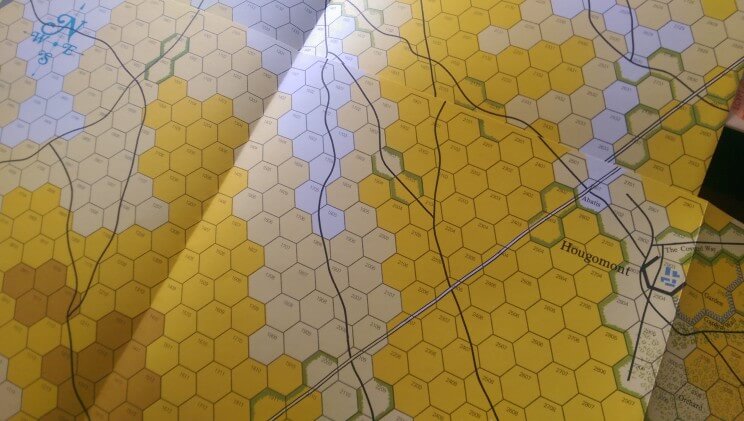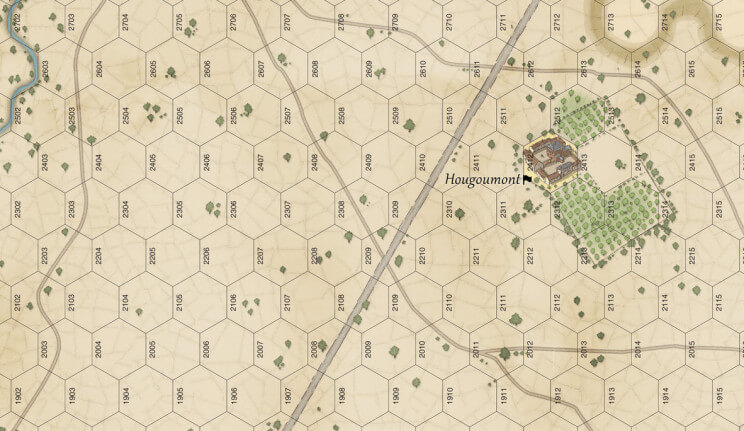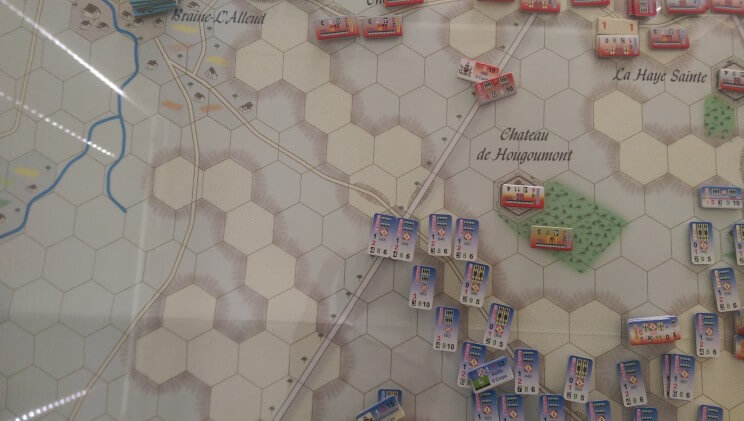Pire’s Cav is on the ‘plateau’ at about 130 feet high. The hill falls away down to 110 by the looks of it over a fairly short distance. The variation in terrain examination was prompted by Waterloo 200’s lack of Western flanking opportunities. Why was that cut off?
The designer felt that due to weather and terrain that the Western parts of the area were not suited to moving troops, but in particular artillery.
What do other games I own have to show us?
Wellingtons Victory the SPI/TSR title gives a very detailed look at the terrain with 4 levels of terrain across 100 yard hexes. It seems to paint a broader picture than historically. But it also suffers from some other miss location of geography.
The new kid on the block Fallen Eagles provides this to area to play with, and deems it flat. In game terms not steep enough to matter as a hill or slope such as around Le Haie Saint. I think hexes are in the 200m range in terms of size.
The Return of the Emperor, shows the hills as a one level variation. This is consistent across the entire map. Here hexes are 250 m on this map.
All the maps that add this area seem to play that terrain gently. Hard to say which is design for effect.
What other Waterloo games have differing details for terrain?
Chandler’s Campaigns of Napoleon does not refer much to the topographical nature of the Chateau area, but does refer to the sodden nature of the ground.




I have been on the battlefield 6 times and I have been in that area on at least two occasions, although it has been a long while ago. That said I did have the Wellington’s Victory maps with me and I think its portrayal seemed consistent with what I saw. Of course when I saw it in the late 80’s the terrain could have changed quite a bit, but I do not recall any abrupt terrain feature in that area.
I know that the designer of Fallen Eagles has been over that ground several times and I think his map captures what is there. Was it more abrupt 200 years ago, possibly, but the other question is how accurate is the map portrayed at the beginning of this post. I have found that even period maps have mistakes.
Mark
Thanks for the insight Mark. In many cases the extent of the map is a specific design choice.
I’ve looked at maps and wargame maps. The new maps for Grognard’s Waterloo set show the terrain from new topo maps with considerable more accuracy than the older La Bataille maps. They clearly indicate the impracticability of a sweep around Wellington’s western flank. There’s a Netherland (IIRC) Division in the villages that would slow you down and allow the British units nearby to deploy. Yes, there are lots of fine British brigades nearby and lovely terrain for them to occupy in a a fishhook with Hugomont as the pivot-point.
Also, if you drove the British to the east you help them unite with the Prussians. The eastern flank offers more opportunity. The British and French infantry are roughly equal in numbers and the weaker allies are balanced by some exceptional British infantry. The one great French advantage is in artillery, roughly 250 guns to 150 Allied and the French guns are of larger caliber. You must get them astride Wellington’s Ridge so the English cannot hide in defilade. So, screen the small chateau on the British left (east) and get astride the ridge as you send light cavalry to delay the Prussians. Send VI Corps to hold Blucher and use your artillery to attrit the wonderful British infantry.
Sweeping around to the west won’t likely succeed. Sweeping around the east is the better choice. Only two mixed divisions and a Dutch division. on the end.
Great data. Thanks for sharing.
In John Tiller’s Battleground: Waterloo computer game, the computer program will occasionally make a major flanking operation on this side of the map at the start of the game. If this is something you’re really interested in, it’s worth a look. The whole corps on that side of the battlefield marches around Hougoumont on the north side, eventually followed up by (the idea being to draw reserves away from the center) a total frontal attack in the center.